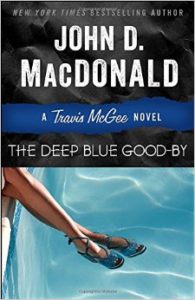John D. MacDonald’s Travis McGee books spans 21 novels across 21 years. They were published between 1964 and 1985, which roughly correspond to the first two decades of my life. Growing up I remember seeing (and probably reading) several of the McGee novels in my parents’ library, as all the titles contain a color in the name. They also usually featured bikini-clad women, which to a teenage boy must have seen like incentive enough to read the books. However, unlike many of the novels by Dick Francis that I read around the same time during formative teenage years, I remember little about MacDonald’s books, except that they were set somewhere along the coast in the US.
Recently I read the first book in the series, The Deep Blue Good-By. Instead of a fading paperback with an embarrassing cover, the recently republished trade paperback edition’s cover is far more sedate, showing only elegant legs dangling over a swimming pool. Noted writers such as Stephen King, Mary Higgins Clark and Jonathan Kellerman provide blurbs, while Lee Child pens the introduction.

The protagonist, Travis McGee, hires himself out as a person who retrieves stolen property. People who can’t get back their property through regular channels turn to McGee. The work is such that he spends downtime relaxing on his large houseboat, the Busted Flush, somewhere in Florida. He works only when his funds run low, usually able to pick and choose his various jobs. As the book opens he’s currently between jobs, letting his houseboat be used as a space for a friend to tune her dance routine. McGee, the eternal gentleman, gently rebuffs her advances after her routine, which makes her both angry and thankful. This introduces to the reader a sense that McGee has a moral code, one that slips slightly after he picks up a young college student at a bar for a one-night stand later.
The dancer is there not just to highlight McGee’s ethics, but she also introduces him to a new job, Cathy Kerr. One of her dancers had her family fortune stolen by a conniving ex-lover, who used her to find a fortune in jewels smuggled back from Asia after WWII by her father. Junior Allen, a sadistic and manipulative person, had spent time in military prison with Cathy’s father, who died in prison after boasting he had a hidden fortune somewhere back home. Allen seduced Cathy, learned all he could about her father, then dumped Cathy and showed up a few months later a wealthy man with a high society woman on his arm like a trophy. Now Cathy wants to retrieve part of her fortune, for the sake of her family.
The actual work undertaken by McGee is cautious and indirect. He never confronts Allen, but gathers information through research and surveillance, with a dash of deception. Via his research McGee comes across Lois Atkinson, the high society woman last seen with him as he parade his new-found wealth around Cathy’s town in the Florida Keys. Used and abused by Allen both physically and psychology, Lois is a wreck barely hanging onto existence when McGee finds her. He nurses her back to health and sanity first at her house and then aboard the Busted Flush, while planning how to get the better hand of Allen. Yet Allen is not only sadistic, but cautious. He thwarts McGee’s plan to travel as a guest on Allen’s boat into the Gulf, and when Lois arrives to rescue him she’s taken prisoner as well.
With everyone aboard Allen’s boat, we get to the meaning of the title of the novel. Amid the deep blue waters of the Gulf Stream some of the characters will truly say farewell to life, in a most brutal fashion.
The action of the novel spans only a small portion of the book. The rest establishes the characters, settings, and background, building tension slowly until a sudden rush that’s almost shocking in speed and force.
Published over fifty years ago, The Deep Blue Good-By stands the test of time with mixed results. When the novels first appeared, McGee might have been a unique character. Today, with so many similar characters in fiction and movies, that uniqueness seems diminished. MacDonald’s writing at times seems dated, his view on gender old-fashioned. The prose is tight, descriptions of people and places vivid. Some of the prose is rough around the edges, but in this first book of the long series Travis McGee stands out as a unique character. I certainly intend to continue reading the series. There’s a mix of both the hard-boiled and more gentler themes, at least in this book.